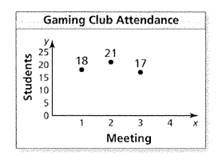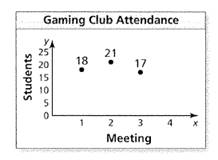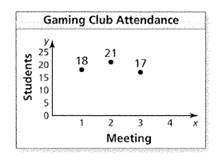
Concept explainers
a.
To identify if the number of students greater than or less than 20
a.
Answer to Problem 50E
Greater than 20
Explanation of Solution
Given:

Concept used:
Mean is the sum of all the data present divided by the given frequency.
Calculation:
In the given figure the following data can be considered:

The number of students who attended the:
1st meeting = 18
2nd meeting = 21
3rd meeting = 17
4th meeting = x (Say)
Also, mean of the four meetings is 20.
Therefore, according to the given condition,
Conclusion:
Hence, the number of students who attended in the 4th meeting will be greater than 20.
b.
To identify the number of students who attended the 4th meeting.
b.
Answer to Problem 50E
24
Explanation of Solution
Given:

Concept used:
Mean is the sum of all the data present divided by the given frequency.
Calculation:
In the given figure the following data can be considered:

The number of students who attended the:
1st meeting = 18
2nd meeting = 21
3rd meeting = 17
4th meeting = x (Say)
Also, mean of the four meetings is 20.
Therefore, according to the given condition,
Conclusion:
Hence, the number of students who attended in the 4th meeting will be 24.
c.
To describe a way to estimate the value in part (b)
c.
Explanation of Solution
Given:

Calculation:
From the given graph it is clear that: (negative sign represents less than mean and positive sign represents greater than mean)
Number of students in 1st meeting with respect to the mean = (18 - 20) = -2
Number of students in 2nd meeting with respect to the mean = (21 - 20) = +1
Number of students in 3rd meeting with respect to the mean = (17 - 20) = -3
Now, the mean has to be 20 after considering the count of 4th meeting.
The net coming out of the previous 3 meetings should be added to 20 to attain the number of students required for the 4th meeting.
Therefore, Net = (-2) + 1 + (-3) = -4, which means the net value is short of 4 units which should be added to the mean to obtain the 4th value.
Hence, the number of students in the 4th meeting will be = 20 + 4 = 24.
Conclusion:
Hence, by the above method the data could be manipulated to obtain the required data.
Chapter 1 Solutions
BIG IDEAS MATH Algebra 1: Common Core Student Edition 2015
- 1) Use the roster method to list the elements of the set consisting of: a) All positive multiples of 3 that are less than 20. b) Nothing (An empty set).arrow_forward2) Let M = {all postive integers), N = {0,1,2,3... 100), 0= {100,200,300,400,500). Determine if the following statements are true or false and explain your reasoning. a) NCM b) 0 C M c) O and N have at least one element in common d) O≤ N e) o≤o 1arrow_forward4) Which of the following universal sets has W = {12,79, 44, 18) as a subset? Choose one. a) T = {12,9,76,333, 44, 99, 1000, 2} b) V = {44,76, 12, 99, 18,900,79,2} c) Y = {76,90, 800, 44, 99, 55, 22} d) x = {79,66,71, 4, 18, 22,99,2}arrow_forward
- 3) What is the universal set that contains all possible integers from 1 to 8 inclusive? Choose one. a) A = {1, 1.5, 2, 2.5, 3, 3.5, 4, 4.5, 5, 5.5, 6, 6.5, 7, 7.5, 8} b) B={-1,0,1,2,3,4,5,6,7,8} c) C={1,2,3,4,5,6,7,8} d) D = {0,1,2,3,4,5,6,7,8}arrow_forward5) 8.4 6.3 ?arrow_forwardWendy is looking over some data regarding the strength, measured in Pascals (Pa), of some rope and how the strength relates to the number of woven strands in the rope. The data are represented by the exponential function f(x) = 2x, where x is the number of woven strands. Explain how she can convert this equation to a logarithmic function when strength is 256 Pascals. Please type out answerarrow_forward
- Harrison and Sherrie are making decisions about their bank accounts. Harrison wants to deposit $200 as a principal amount, with an interest of 2% compounded quarterly. Sherrie wants to deposit $200 as the principal amount, with an interest of 4% compounded monthly. Explain which method results in more money after 2 years. Show all work. Please type out answerarrow_forwardMike is working on solving the exponential equation 37x = 12; however, he is not quite sure where to start. Solve the equation and use complete sentences to describe the steps to solve. Hint: Use the change of base formula: log y = log y log barrow_forwardUsing logarithmic properties, what is the solution to log3(y + 5) + log36 = log366? Show all necessary steps.arrow_forward
 Algebra and Trigonometry (6th Edition)AlgebraISBN:9780134463216Author:Robert F. BlitzerPublisher:PEARSON
Algebra and Trigonometry (6th Edition)AlgebraISBN:9780134463216Author:Robert F. BlitzerPublisher:PEARSON Contemporary Abstract AlgebraAlgebraISBN:9781305657960Author:Joseph GallianPublisher:Cengage Learning
Contemporary Abstract AlgebraAlgebraISBN:9781305657960Author:Joseph GallianPublisher:Cengage Learning Linear Algebra: A Modern IntroductionAlgebraISBN:9781285463247Author:David PoolePublisher:Cengage Learning
Linear Algebra: A Modern IntroductionAlgebraISBN:9781285463247Author:David PoolePublisher:Cengage Learning Algebra And Trigonometry (11th Edition)AlgebraISBN:9780135163078Author:Michael SullivanPublisher:PEARSON
Algebra And Trigonometry (11th Edition)AlgebraISBN:9780135163078Author:Michael SullivanPublisher:PEARSON Introduction to Linear Algebra, Fifth EditionAlgebraISBN:9780980232776Author:Gilbert StrangPublisher:Wellesley-Cambridge Press
Introduction to Linear Algebra, Fifth EditionAlgebraISBN:9780980232776Author:Gilbert StrangPublisher:Wellesley-Cambridge Press College Algebra (Collegiate Math)AlgebraISBN:9780077836344Author:Julie Miller, Donna GerkenPublisher:McGraw-Hill Education
College Algebra (Collegiate Math)AlgebraISBN:9780077836344Author:Julie Miller, Donna GerkenPublisher:McGraw-Hill Education





